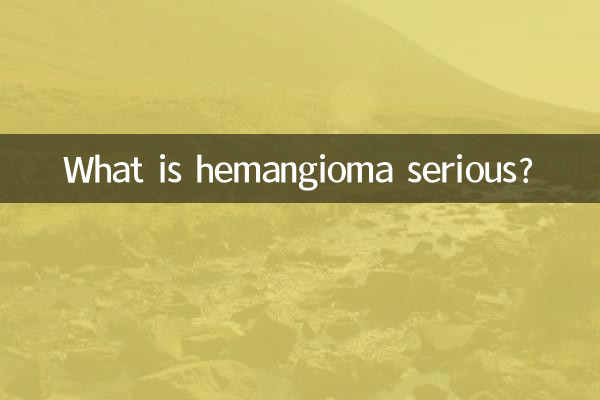What is hemangioma serious?
Hemangioma is a common benign tumor mainly formed by the proliferation of vascular endothelial cells. It can occur anywhere on the body, but is more common in the skin and soft tissue. In recent years, the topic of hemangioma has attracted much attention on social media and medical forums. This article will combine the hot topics and hot content on the Internet in the past 10 days to provide you with a detailed analysis of the severity, types, symptoms and treatment methods of hemangioma.
1. Types of hemangiomas

Hemangiomas can be divided into the following categories based on their morphology and growth characteristics:
| Type | Features | Common parts |
|---|---|---|
| capillary hemangioma | Formed by the proliferation of capillaries and appear red or purple | skin, face |
| cavernous hemangioma | It is composed of larger vascular spaces and has a soft texture. | subcutaneous tissue, internal organs |
| vine hemangioma | Composed of tortuous dilated blood vessels, often accompanied by arteriovenous fistulas | limbs, head |
2. Severity of hemangioma
The severity of hemangiomas varies by type, location, and size. Most hemangiomas are benign and do not cause serious health effects. However, in some cases, hemangioma may cause the following problems:
| Severity | possible impact | Countermeasures |
|---|---|---|
| Mild | Only affects appearance, no other symptoms | Regular observation, no treatment required |
| Moderate | May cause pain, bleeding, or infection | Medication or topical treatment |
| Severe | Compresses surrounding organs and affects function | Surgical resection or other interventional treatment |
3. Symptoms of hemangioma
Symptoms of hemangioma vary depending on the type and location. The following are common symptoms:
| Symptoms | Description | Common types |
|---|---|---|
| red spots or bumps on the skin | Red or purple, may fade when pressed | capillary hemangioma |
| pain or tenderness | Occurs when the tumor grows or becomes infected | cavernous hemangioma |
| bleeding or ulcers | Damage to the tumor surface causes | vine hemangioma |
4. Treatment methods for hemangioma
Treatment of hemangioma requires an individualized plan based on its type, size, and location. The following are common treatments:
| Treatment | Applicable situations | Advantages and Disadvantages |
|---|---|---|
| drug treatment | Early or smaller hemangiomas | Non-invasive, but the treatment course is longer |
| laser treatment | superficial capillary hemangioma | Accurate, but requires multiple treatments |
| surgical resection | Large or deep hemangioma | Thorough, but may cause scarring |
5. Analysis of hot topics on the entire network in the past 10 days
By combing through the hot topics on the Internet in the past 10 days, we found that the discussion of hemangiomas mainly focuses on the following aspects:
| topic | heat index | main focus |
|---|---|---|
| Can hemangiomas become cancerous? | high | Risk of malignant transformation of benign tumors |
| Treatment of infantile hemangioma | in | Natural regression of infantile hemangiomas |
| Prevention of hemangiomas | low | The relationship between living habits and hemangioma |
6. Summary
The severity of hemangiomas varies from individual to individual, but in most cases they are benign lesions and there is no need to worry too much. However, for hemangioma that grows rapidly, has a special location or has obvious symptoms, you should seek medical treatment promptly to avoid delaying treatment. Through scientific diagnosis and reasonable treatment, hemangioma can usually be effectively controlled.
If you or your family members find symptoms of suspected hemangioma, it is recommended to consult a professional doctor as soon as possible to obtain personalized diagnosis and treatment suggestions.

check the details

check the details